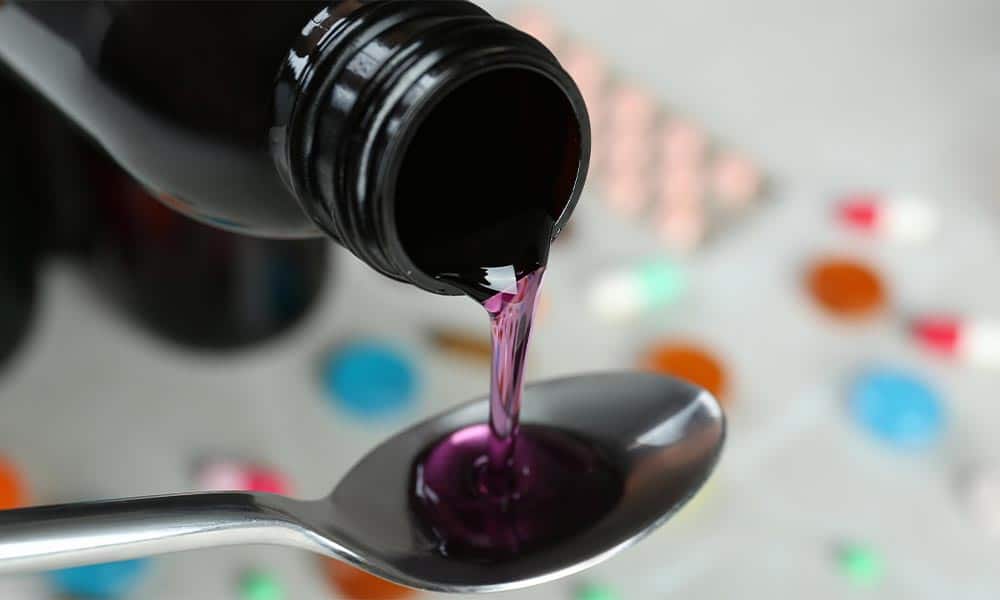Stilpane syrup is one of several available cough syrups that contain promethazine and codeine, an opioid. It’s often used on a short-term basis to treat colds and upper respiratory infections. Stilpane syrup is often abused. When misused, this drug combination can be dangerous, potentially leading to adverse effects such as addiction and overdose.
Active Stilpane Syrup Ingredients
Stilpane syrup is a potent opioid combination medication that contains three separate active ingredients.
Codeine
The most powerful ingredient in Stilpane syrup is codeine. Codeine is a controlled substance that has been linked to an increased risk of substance abuse and addiction. [1] Codeine is a central nervous system depressant. Taking too much of it could lead to slowed breathing and the potential for overdose.
Promethazine
Promethazine is an antihistamine drug used to treat cold and allergy symptoms such as sneezing, watery eyes, and a runny nose. It’s sometimes prescribed off-label for conditions such as motion sickness or morning sickness associated with pregnancy. [2]
Paracetamol
Paracetamol, also known as acetaminophen, is an analgesic used to treat mild or moderate pain. [3] It’s often used in cough and cold medicine, including prescription and over-the-counter medications.
Side Effects of Stilpane Syrup
Some people experience unwanted side effects after taking Stilpane syrup. Common side effects of this combination drug include: [4]
- Constipation
- Nausea
- Dry mouth
- Anxiety
- Restlessness
- Sweating
- Shortness of breath
- Dizziness
- Confusion
- Headache
- Problems with coordination
- Trouble urinating
- Fatigue
- Drowsiness
If these side effects are bothersome or persist for more than a few days, contact your healthcare provider.
Stilpane Syrup Precautions
Stilpane syrup isn’t available without a prescription. Never take this opioid combination drug unless directed by a doctor. Here are some other precautions to take when considering a codeine cough syrup like Stilpane syrup: [5]
- Never take more Stilpane syrup than prescribed by a doctor, even if you think the medication isn’t working properly. If you’re still having cough and cold symptoms, contact your healthcare provider.
- Tell your doctor if you want to discontinue Stilpane syrup. They may want to taper your dose to avoid uncomfortable or even dangerous withdrawal effects. Don’t stop or adjust your dose of Stilpane syrup without first consulting with a medical professional.
- Always tell your doctor about any medications you’re taking or any medical conditions you have (or have had in the past).
- Don’t take Stilpane syrup if you have asthma, narrow-angle glaucoma, problems with urination, or a bowel obstruction.
- Children under the age of 12 should never take codeine cough syrup like Stilpane syrup.
- Don’t take Stilpane syrup if you are pregnant or planning to become pregnant. Doing so could cause your unborn baby to become addicted to codeine.
- Don’t take Stilpane syrup if you are breastfeeding, since it can pass into breast milk and cause your newborn to have adverse effects, including death.
Dangers of Stilpane Syrup
Stilpane syrup poses some risks to users, and these risks are amplified for people who misuse this drug by using it recreationally.
Addiction to Codeine
As an opiate narcotic, codeine carries the risk of physical dependence. If you or a loved one develops an addiction to this substance, there will be signs of codeine dependence, including: [6]
- Taking a larger dose than intended or taking codeine for longer than intended
- Spending a lot of time acquiring codeine, using it, or recovering from use
- Using opioids in dangerous or risky situations
- Intense cravings for codeine
- Dropping other activities from your calendar in order to use codeine
- Difficulty living up to responsibilities due to codeine use
- Continuing to use opioids like codeine despite their causing relationship problems
- Trying to quit or cut back on codeine use unsuccessfully
- Needing more codeine to experience the same effects (i.e., building tolerance)
- Experiencing withdrawal symptoms when abstaining from codeine
Experiencing just two or more of these symptoms over the course of a year could indicate opioid use disorder, or codeine addiction, according to the American Psychiatric Association’s Diagnostic and Statistical Manual of Mental Disorders, Fifth Edition (DSM-5). More than three symptoms could indicate a moderate or severe substance use disorder. Even mild symptoms should be addressed, as these disorders tend to progress quickly when left untreated.
Codeine Withdrawal Symptoms
Codeine withdrawal is a telltale symptom of opioid use disorder. These withdrawal symptoms may include: [7]
- Insomnia
- Runny nose
- Sweating excessively
- Muscle aches
- Anxiety
- Agitation
- Stomach cramping
- Nausea
- Vomiting
- Dilated pupils
- Goosebumps
- Diarrhea
In some cases, withdrawal from opioids can be dangerous. It’s best to detox in a hospital or treatment facility under medical supervision.
Codeine Overdose
Using codeine recreationally or without a prescription could increase your risk of overdose. Overdosing on codeine can be fatal. If a loved one is experiencing any of the following symptoms of overdose after taking Stilpane syrup or any other drug containing codeine, call 911 or go to the nearest emergency room: [8]
- Trouble breathing
- Slow or shallow breathing
- Limp limbs
- Slow heart rate
- Extreme drowsiness or sedation
- Cold, clammy skin
- Pinpoint pupils
- Unresponsiveness
- Snoring or gurgling sounds from the mouth
If you have naloxone, administer it to reverse the effects of the overdose and seek medical attention. You can also call the poison control helpline at 1-888-222-1222.
Practical Addiction Treatment Solutions Are Here To Help
If you or a loved one is experiencing addiction to an opiate drug like codeine or any other drug, know that you’re not alone. Millions of people have been where you are, and there is evidence-based treatment available for substance use disorder.
A compassionate substance use and rehabilitation counselor can discuss treatment options with you, such as medical detox services, inpatient or partial hospitalization programs, intensive outpatient treatment, and relapse prevention services. Recovery is within your reach.














































